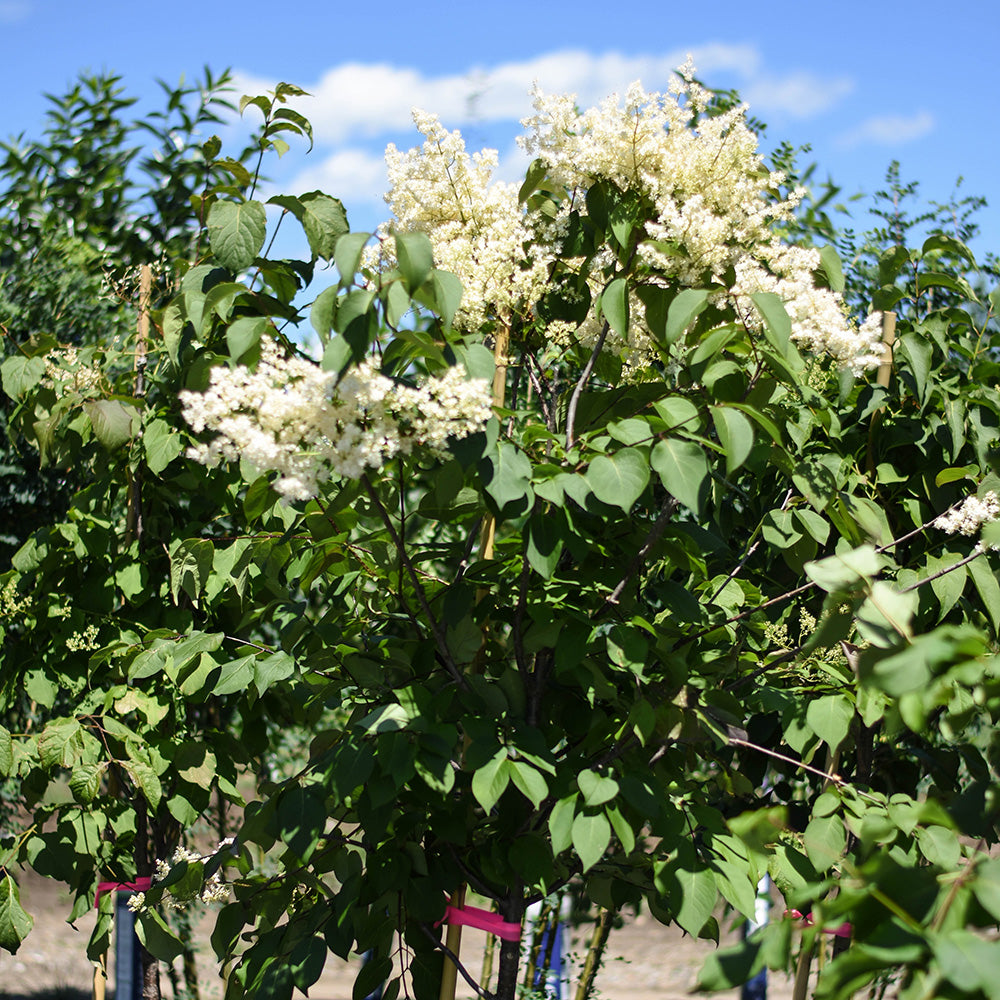Riverdene Garden Center
Ivory Silk Japanese Tree Lilac
Ivory Silk Japanese Tree Lilac
Couldn't load pickup availability
Syringa reticulata ‘Ivory Silk’
Ivory Silk Japanese Tree Lilac is a compact, small ornamental tree known for its large, creamy-white flower clusters, fragrant summer blooms, and attractive, exfoliating bark. Unlike traditional lilacs, this variety blooms in early summer, extending the lilac season. It is cold-hardy (Zone 3-7), disease-resistant, and low-maintenance, making it an excellent choice for street plantings, specimen trees, and urban landscapes in Southwest Saskatchewan.
Planting & Location
- Hardiness Zone: 3-7 (thrives in prairie climates and cold winters)
- Mature Size: 20-25 feet tall, 15-20 feet wide
- Growth Rate: Moderate (12-24 inches per year)
- Sunlight Needs: Full sun (6+ hours of direct sunlight for best flowering)
-
Soil Preference:
- Prefers well-drained, loamy soil.
- Tolerates clay, sandy, and slightly alkaline soils.
- Avoid wet or compacted soil—lilacs dislike soggy roots.
- Spacing: 15-20 feet apart for individual trees, closer for avenue plantings.
Watering
- Young Trees (First 1-2 Years): Water deeply once per week to establish roots.
- Established Trees: Drought-tolerant; water every 2-3 weeks in dry periods.
- Avoid Overwatering: Prefers moderate soil moisture but does not tolerate standing water.
Fertilizing
- First Year: No fertilizer needed—focus on root establishment.
-
Mature Trees:
- Apply a balanced slow-release fertilizer (e.g., 10-10-10) in early spring to support flowering.
- Organic alternative: Compost or well-rotted manure in spring.
- Avoid excessive nitrogen, as it promotes leafy growth over blooms.
Pruning & Maintenance
- Best Time to Prune: Late winter to early spring (before new growth starts).
-
How to Prune:
- Remove dead, diseased, or crossing branches.
- Maintain a strong central leader and lightly shape if needed.
- Avoid heavy pruning, as flowers bloom on new wood.
Flowering & Fragrance
- Bloom Time: Early to mid-summer (June-July, after common lilacs finish blooming)
- Flower Color: Large, creamy-white, fragrant flower clusters (10-12 inches long)
- Fragrance: Sweet, mild honey-like scent (not as strong as French lilacs)
- Attracts: Bees, butterflies, and pollinators
Pest & Disease Management
Resistant to: Powdery mildew, lilac borers, and bacterial blight (common lilac diseases).
Common Pests:
-
Aphids – Can cause curled leaves and sticky honeydew.
- Solution: Spray with insecticidal soap or introduce ladybugs.
-
Japanese Beetles – Can skeletonize leaves in some regions.
- Solution: Hand-pick or use neem oil.
Common Diseases:
-
Leaf Spot (Fungal or Bacterial) – Causes brown leaf spots.
- Solution: Improve airflow and remove infected leaves.
-
Verticillium Wilt – Affects vascular system, causing branch dieback.
- Solution: Avoid planting in previously infected soil; prune affected branches.
Winter Protection
- Highly winter-hardy—no special protection needed.
- Mulching: Apply 2-4 inches of mulch around the base (not touching the trunk) to insulate roots.
- Rodents & Deer: Generally resistant, but tree guards may help protect young trees.
Landscape Uses
Excellent as a specimen tree in yards or parks
Beautiful summer blooms extend the lilac season
Fragrant flowers attract pollinators
Cold-hardy and disease-resistant
Ideal for street plantings, mixed borders, and urban landscapes
Additional Notes:
- Ivory Silk Japanese Tree Lilac is a great alternative to traditional lilacs for urban areas, narrow spaces, and locations needing a summer-blooming ornamental tree.
- Lifespan: 50+ years with proper care.
- Works well as a street tree, focal point in gardens, or mixed with other shrubs and perennials.
Photo courtesy of Foothills Nurseries
Share


